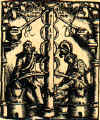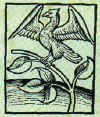 16th Century
German Herbal Distillery
16th Century
German Herbal DistilleryHumoral Pathology:
Throughout the ancient world there emerged classificatory systems about the earth and universe and how the human body interacted with the elements, plants and animals. In the Greek system at the time of Hippocrates (468-377 B.C.) they recognized four primary elements: water, earth, air and fire. A fifth element, ether, was identified as a nebulous nothingness filling all unoccupied space, but not being a factor effecting ones health. The four main elements were related to seasons, bodily fluids (called humors), fundamental physical qualities (hot/cold; wet/dry) and even human temperaments. Such a belief system was referred to as the humoral pathology. Other life forms in the plant and animal world had associative qualities with the elements that could have an effect on a person's health, mood, and spiritual receptivity. Here is a simple schematic of the Greek humoral pathology:
| Season: | winter | COLD |
Season: | fall |
| Fluid: | phlegm | Fluid: | black bile | |
| Temperament | phlegmatic | Temperament | melancholic | |
Water |
Earth |
|||
WET |
+ |
DRY |
||
Air |
Fire |
|||
| Season: | Spring | Season: | summer | |
| Fluid: | blood | Fluid: | yellow bile | |
| Temperament | sanguine | HOT |
Temperament | choleric |
When a person was sick your body was excessively hot, cold, wet, or dry by varying degrees and counteractive qualities of foods/herbs/medicines were used to restore balance. For instance during the winter cold and dampness (e.g. cold 4/wet 5) were thought to produce upper respiratory infections (URI) and would be counteracted with herbs like thyme and hyssop that were warm and dry. Today's medical assessment does not attribute colds to cold weather and would at best conclude that cold weather lowers resistance thus aiding the spread of micro-organisms. Yet thyme and hyssop are herbs that have expectorant, astringent, diuretic, and anti-secretory action that basically gets rid of phlegm. There are other factors (behavioral, food, spiritual, etc.) involved, but such a system gave a foundation action reaction of the human body to its environment that often worked (at least symtomatically) for various reasons.
 16th Century
German Herbal Distillery
16th Century
German Herbal Distillery
The classic text written by Pedanius Dioscorides (ca A.D. 60) and updated texts by Claudius Galenus (A.D. 131-199) became standard guides for most of the Roman world even into medieval times. The Arab world elaborated Galenic medicine in the text called Kitab al Qanun (Canon of Medicine) by Avicenna. Eventually Avicenna's work and system (known as Unani) with many new Asian herbs and medicines, like cloves, nutmeg, saffron, and senna, came back to the Western medicine with Latin translations appearing around the 12th century.
The East had developed similar systems as far back as 2500 B.C. and had probably been influencing the Western medicine all along. In India the Ayurvedic system links the bodies chakras or energy centers associated with organs of the body with primal forces prana (breath of life), agni (spirit of light or fire) and soma (manifestation of harmony). There are five elements of all matter: earth, water, fire, air, and ether which are converted by agni (digestive fire) into three humors kapha (phlegm), pitta (fire/bile) and vata (wind) respectively. Again food, herbs/medicine, and other factors including emotion and behavior effect the balance of the humors at each of the chakras. In China a similar system developed with the ancient text of the legendary Yellow Emperor (Huang Ti) probably derived from the ancient Taoist text Nei Ching. With the underpinnings of the polar opposites yin (female, dark,cold) and yang (male, light, hot) that are characteristic of all things including men and women one combines the interaction of body fluids and energy channels or meridians called qi with the elements. In the Chinese system there are five elements: wood, fire, metal, earth, water which are in turn associated with seasons, taste, emotion, parts of the body and herbs/medicine.
These three systems have a long history of going in and out of favor as they influence each other over the ages. After a relative long period of isolation the Americas with the Columbian Exchange a whole new body of knowledge was introduced, especially to European pharmacology. As Western science rises to dominance the European system of humoral pathology diminishes. However, Western sciences initial lineal and reductionistic approach eventually stimulated a revival of holistic approaches that includes these older systems of humoral pathologies. The net effect is to reevaluate the efficacy of these systems in light of modern science (with mixed results) and more importantly to stimulate modern medicine to be more holistic.
 Caladrius, bird
of healing, from Hortus Sanitatis (1497)
Caladrius, bird
of healing, from Hortus Sanitatis (1497)
On the lighter side these humoral systems are clearly the basis to most of the world's food cusines. If you assess any presentation of a meal or even courses the foods produce a neutral, heating or cooling effect with a particular taste sequence or combination, coupled with complimentary herbs. For example if you have an Italian pasta dish you start with a neutral bread and pasta with a heating meat/cheese sauce and a cooling salad (anti-pasta). Fresh basil and /or oregano acts as a diuretic to counteract the salt in the meat or cheese which is a necessary preservative. Many dishes have even more subtle combinations especially with salt and sweet/sour in relishes and pickles or bitter/pungent in hot sauces. If your a cook you know it takes practice to get the right balance, but of equal interest is the effect on our bodies.